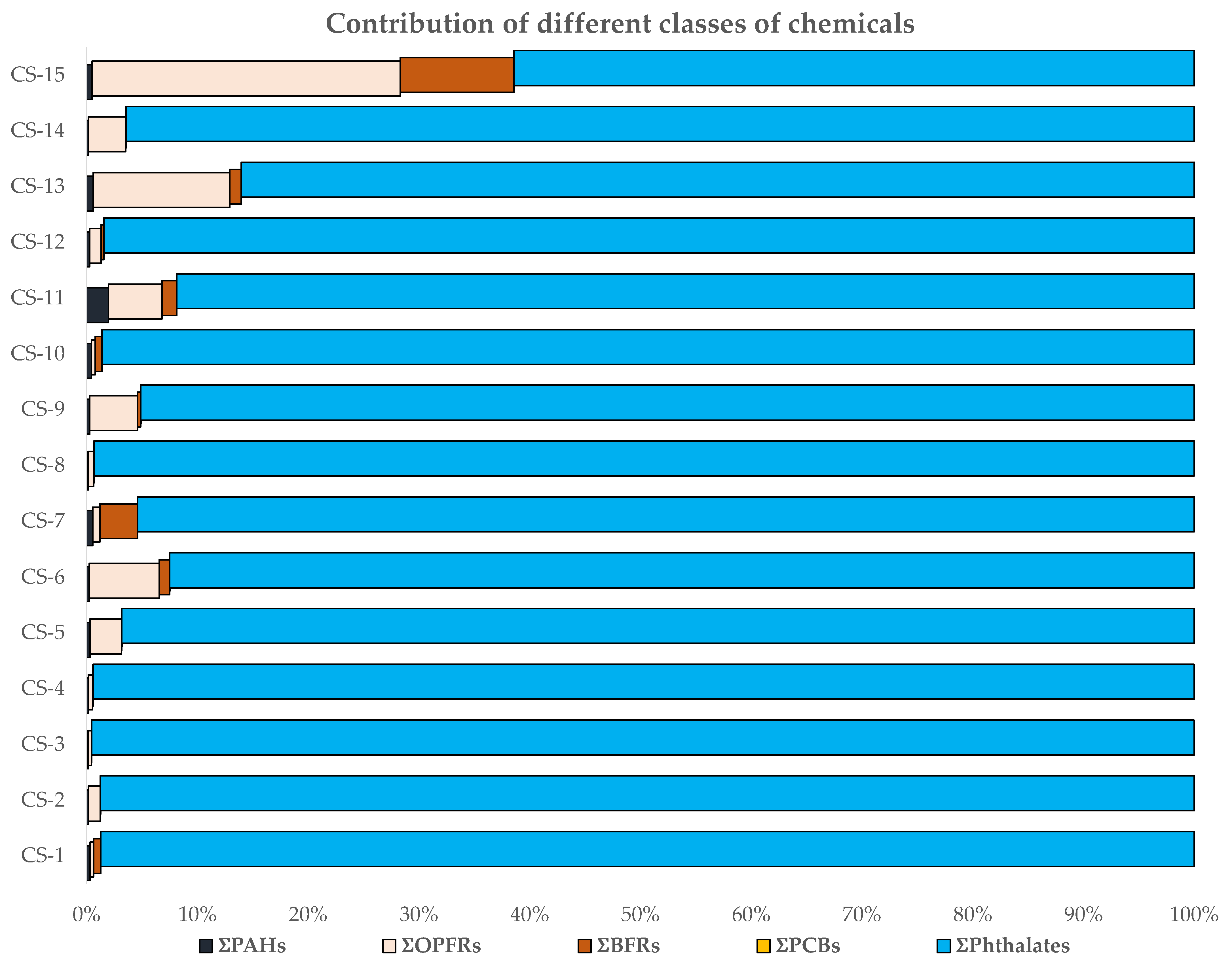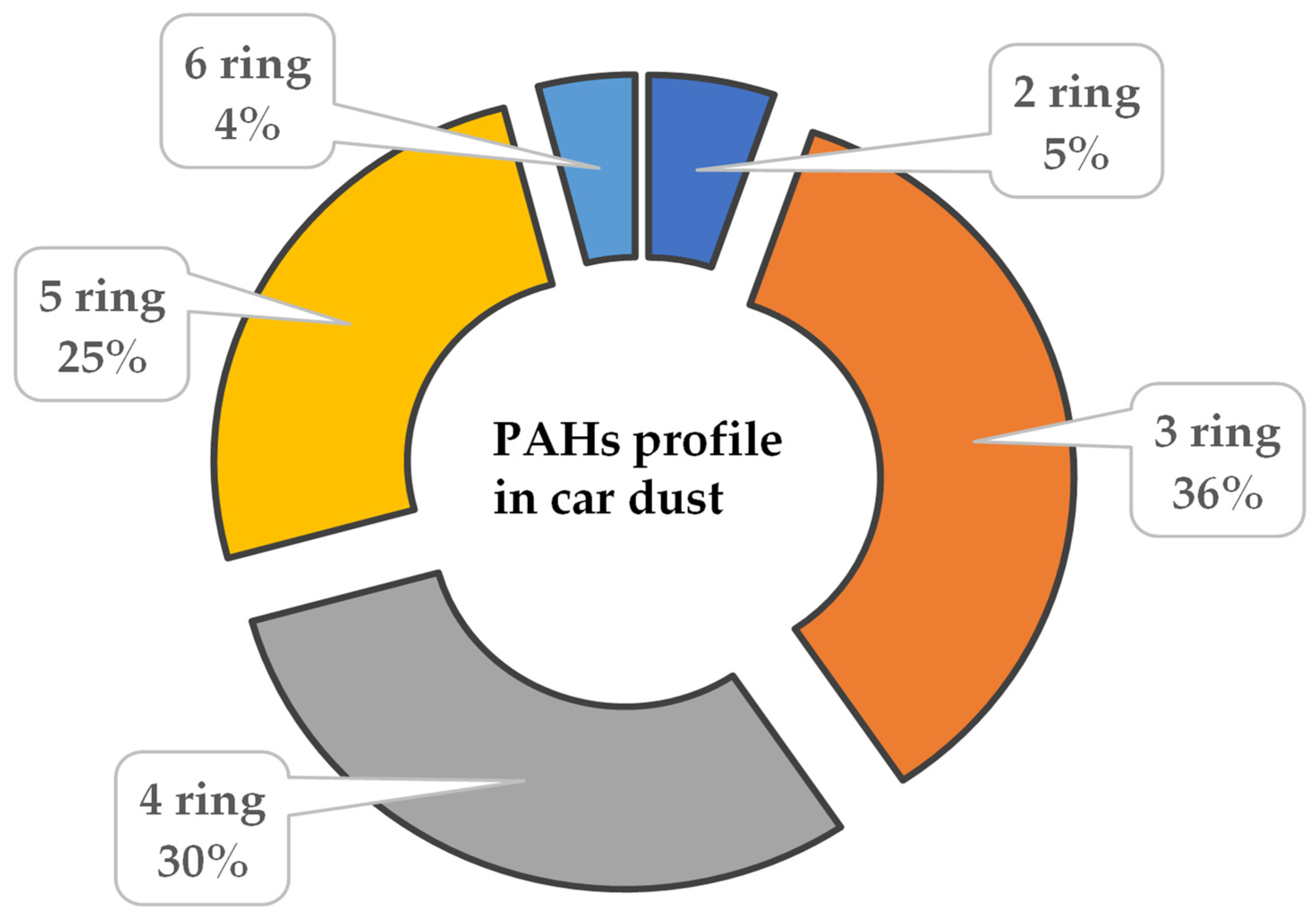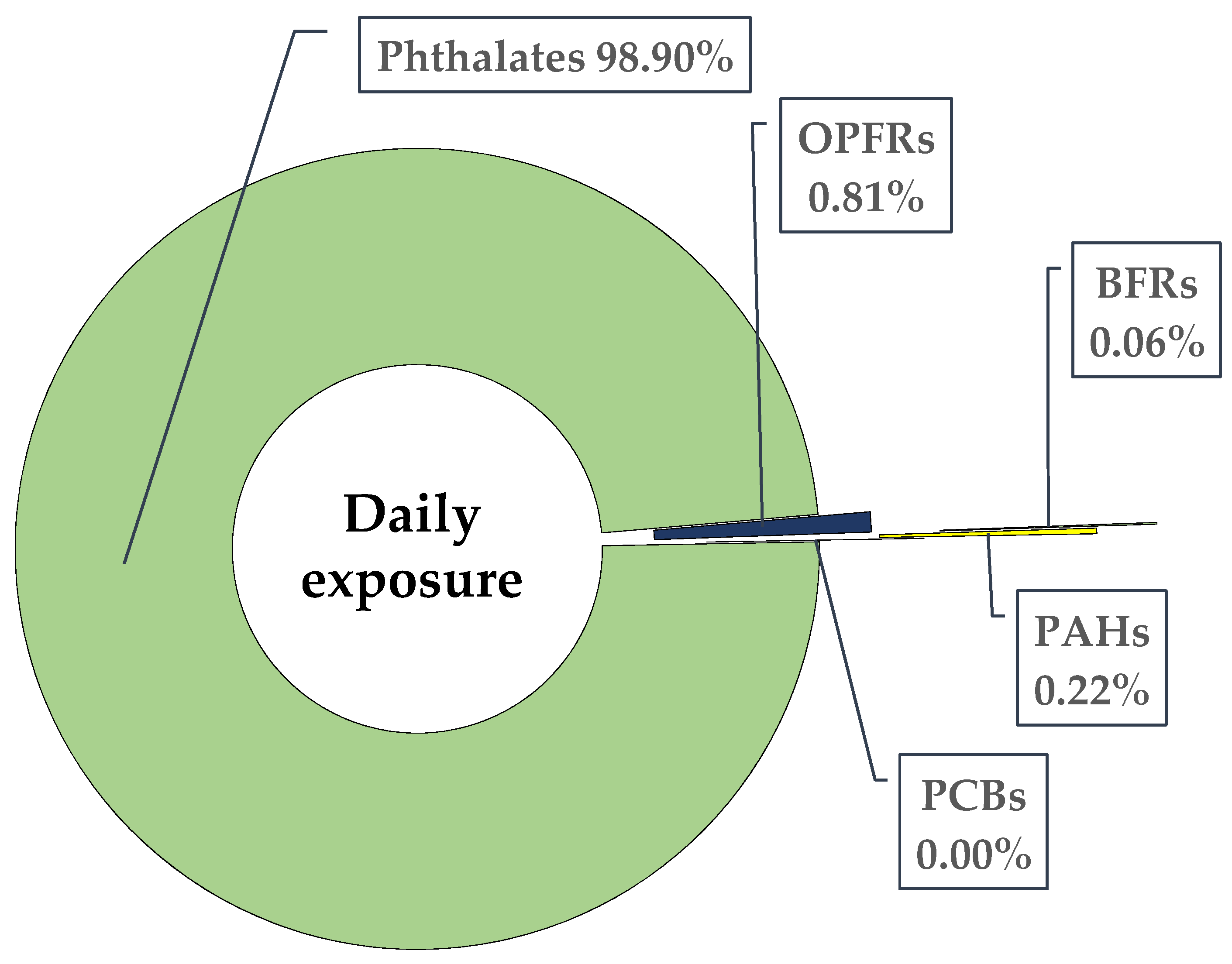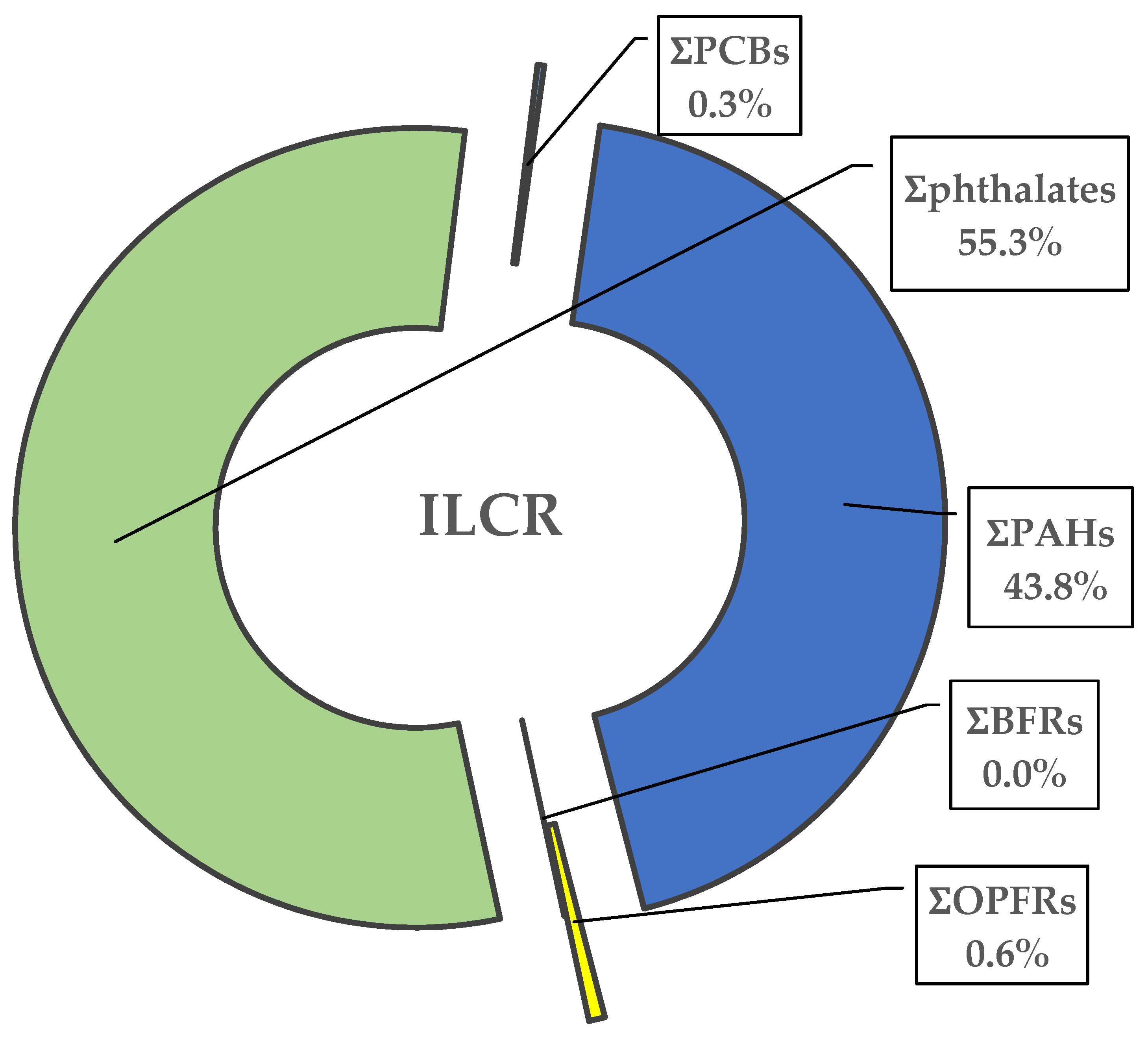Semi-Volatile Organic Compounds in Car Dust: A Pilot Study in Jeddah, Saudi Arabia
Abstract
1. Introduction
2. Materials and Methods
2.1. Sampling and Instrumentation
2.2. Health Risk Assessment Methodology
2.2.1. Exposure Assessment via Dust Ingestion
2.2.2. Incremental Lifetime Cancer Risk (ILCR)
3. Results and Discussion
3.1. The Presence of Different Chemical Groups in Car Dust
3.1.1. Levels and Profiles of Phthalates and PCBs
3.1.2. Levels and Profiles of FRs
3.1.3. PAHs
3.2. Human Risk Assessment
4. Conclusions
Supplementary Materials
Author Contributions
Funding
Data Availability Statement
Acknowledgments
Conflicts of Interest
References
- Gearhart, J.; Posselt, H.; Dempsey, D.; Costner, P.; Griffith, C.; Juska, C. Toxic at Any Speed: Chemicals in Cars and the Need for Safe Alternatives, a Report; Ecology Center: Ann Arbor, Michigan, USA, 2006. [Google Scholar]
- Besis, A.; Christia, C.; Poma, G.; Covaci, A.; Samara, C. Legacy and novel brominated flame retardants in interior car dust–Implications for human exposure. Environ. Pollut. 2017, 230, 871–881. [Google Scholar] [CrossRef]
- Stuart, H.; Ibarra, C.; Abdallah, M.A.E.; Boon, R.; Neels, H.; Covaci, A. Concentrations of brominated flame retardants in dust from United Kingdom cars, homes, and offices: Causes of variability and implications for human exposure. Environ. Int. 2008, 34, 1170–1175. [Google Scholar] [CrossRef] [PubMed]
- Abdallah, M.A.E.; Covaci, A. Organophosphate flame retardants in indoor dust from Egypt: Implications for human exposure. Environ. Sci. Technol. 2014, 48, 4782–4789. [Google Scholar] [CrossRef]
- Albar, H.M.S.A.; Ali, N.; Shahzad, K.; Ismail, I.M.I.; Rashid, M.I.; Wang, W.; Ali, L.N.; Eqani, S.A.M.A.S. Phthalate esters in settled dust of different indoor microenvironments, source of non-dietary human exposure. Microchem. J. 2017, 132, 227–232. [Google Scholar] [CrossRef]
- Yoshida, T.; Matsunaga, I. A case study on identification of airborne organic compounds and time courses of their concentrations in the cabin of a new car for private use. Environ. Int. 2006, 32, 58–79. [Google Scholar] [CrossRef] [PubMed]
- Kalachova, K.; Hradkova, P.; Lankova, D.; Hajslova, J.; Pulkrabova, J. Occurrence of brominated flame retardants in household and car dust from the Czech Republic. Sci. Total Environ. 2012, 441, 182–193. [Google Scholar] [CrossRef] [PubMed]
- Harrad, S.; Abdallah, M.A.E.; Oluseyi, T. Polybrominated diphenyl ethers and polychlorinated biphenyls in dust from cars, homes, and offices in Lagos, Nigeria. Chemosphere 2016, 146, 346–353. [Google Scholar] [CrossRef] [PubMed]
- U.S. Environmental Protection Agency. Indoor Air Quality Home Page. Available online: www.epa.gov/iaq/ (accessed on 15 March 2021).
- Ali, N.; Ali, L.; Mehdi, T.; Dirtu, A.C.; Al-Shammari, F.; Neels, H.; Covaci, A. Levels and profiles of organochlorines and flame retardants in car and house dust from Kuwait and Pakistan: Implication for human exposure via dust ingestion. Environ. Int. 2013, 55, 62–70. [Google Scholar] [CrossRef]
- Ali, N.; Ismail, I.M.I.; Khoder, M.; Shamy, M.; Alghamdi, M.; Costa, M.; Ali, L.N.; Wang, W.; Eqani, S.A.M.A.S. Polycyclic aromatic hydrocarbons (PAHs) in indoor dust samples from Cities of Jeddah and Kuwait: Levels, sources, and non-dietary human exposure. Sci. Total Environ. 2016, 573, 1607–1614. [Google Scholar] [CrossRef]
- Costa, L.G.; Giordano, G.; Tagliaferri, S.; Caglieri, A.; Mutti, A. Polybrominated diphenyl ether (PBDE) flame retardants: Environmental contamination, human body burden and potential adverse health effects. Acta Biomed. 2008, 79, 172–183. [Google Scholar]
- Kamrin, M.A. Phthalate risks, phthalate regulation, and public health: A review. J. Toxicol. Environ. Health Part B 2009, 12, 157–174. [Google Scholar] [CrossRef]
- Meeker, J.D.; Stapleton, H.M. House dust concentrations of organophosphate flame retardants in relation to hormone levels and semen quality parameters. Environ. Health Perspect. 2010, 118, 318–323. [Google Scholar] [CrossRef]
- Kim, K.H.; Jahan, S.A.; Kabir, E.; Brown, R.J. A review of airborne polycyclic aromatic hydrocarbons (PAHs) and their human health effects. Environ. Int. 2013, 60, 71–80. [Google Scholar] [CrossRef]
- Ali, N.; Eqani, S.A.M.A.S.; Ismail, I.M.I.; Malarvannan, G.; Kadi, M.W.; Albar, H.M.S.; Rehan, M.; Covaci, A. Brominated and organophosphate flame retardants in indoor dust of Jeddah, Kingdom of Saudi Arabia: Implications for human exposure. Sci. Total Environ. 2016, 569, 269–277. [Google Scholar] [CrossRef]
- Federal Contaminated Site Risk Assessment in Canada, Part I: Guidance on Human Health Preliminary Quantitative Risk Assess (PQRA). Available online: http://publications.gc.ca/collections/Collection/H46-2-04-367E.pdf (accessed on 10 March 2021).
- Risk Assessment Forum U.S. Environmental Protection Agency. Guidelines for exposure assessment. Fed. Regist. 1992, 57, 22888–22938. [Google Scholar]
- USEPA (United States Environmental Protection Agency). Risk Assessment Guidance for Superfund: Volume III—Part A, Process for Conducting Probabilistic Risk Assessment; EPA 540-R-02-002; USEPA: Washington, DC, USA, 2001.
- United States Environmental Protection Agency Integrated Risk Information System (USEPA IRIS). 2,2′,3,3′,4,4′,5,5′,6,6′-Decabromodiphenyl Ether (BDE-209) (CASRN1163–19-5); US Environmental Protection Agency: Washington, DC, USA, 2016.
- Civan, M.Y.; Kara, U.M. Risk assessment of PBDEs and PAHs in house dust in Kocaeli, Turkey: Levels and sources. Environ. Sci. Pollut. Res. 2016, 23, 23369–23384. [Google Scholar] [CrossRef] [PubMed]
- OECD Environmental Health and Safety Publications. Series on Emission Scenario Documents No. 3, Emission Scenario Document on Plastic Additives, Environment Directorate, Organization for Economic Co-Operation, and Development; OECD Environmental Health and Safety Publications: Paris, France, 2009. [Google Scholar]
- Al-Wabel, M.I.; Usman, A.R.; El-Saeid, M.H.; Al-Turki, A.M.; Hassanin, A.S.; El-Mubarak, A.H. Levels, Sources, and Risk Assessment of Polychlorinated Biphenyls (PCBs) in Soils from Industrial Areas: A Case Study from Saudi Arabia. Polycycl. Aromat. Compd. 2018, 38, 420–433. [Google Scholar] [CrossRef]
- Brommer, S.; Harrad, S.; Van den Eede, N.; Covaci, A. Concentrations of organophosphate esters and brominated flame retardants in German indoor dust samples. J. Environ. Monit. 2012, 14, 2482–2487. [Google Scholar] [CrossRef]
- Ali, N.; Shahzad, K.; Rashid, M.I.; Shen, H.; Ismail, I.M.I.; Eqani, S.A.M.A.S. Currently used organophosphate and brominated flame retardants in the environment of China and other developing countries (2000–2016). Environ. Sci. Pollut. Res. 2017, 24, 18721–18741. [Google Scholar] [CrossRef] [PubMed]
- Covaci, A.; Harrad, S.; Abdallah, M.A.E.; Ali, N.; Law, R.J.; Herzke, D.; de Wit, C.A. Novel brominated flame retardants: A review of their analysis, environmental fate and behaviour. Environ. Int. 2011, 37, 532–556. [Google Scholar] [CrossRef]
- Chen, T.; Yu, D.; Yang, L.; Sui, S.; Lv, S.; Bai, Y.; Sun, W.; Wang, Y.; Chen, L.; Sun, Z.; et al. Thyroid function and decabromodiphenyl ethane (DBDPE) exposure in Chinese adults from a DBDPE manufacturing area. Environ. Int. 2019, 133, 105179. [Google Scholar] [CrossRef] [PubMed]
- Castorina, R.; Butt, C.; Stapleton, H.M.; Avery, D.; Harley, K.G.; Holland, N.; Eskenazi, B.; Bradman, A. Flame retardants and their metabolites in the homes and urine of pregnant women residing in California (the CHAMACOS cohort). Chemosphere 2017, 179, 159–166. [Google Scholar] [CrossRef]
- Chen, T.; Huang, M.; Li, J.; Li, J.; Shi, Z. Polybrominated diphenyl ethers and novel brominated flame retardants in human milk from the general population in Beijing, China: Occurrence, temporal trends, nursing infants’ exposure and risk assessment. Sci. Total Environ. 2019, 689, 278–286. [Google Scholar] [CrossRef] [PubMed]
- Ali, N.; Mehdi, T.; Malik, R.N.; Eqani, S.A.; Kamal, A.; Dirtu, A.C.; Neels, H.; Covaci, A. Levels and profile of several classes of organic contaminants in matched indoor dust and serum samples from occupational settings of Pakistan. Environ. Pollut. 2014, 193, 269–276. [Google Scholar] [CrossRef]
- Vorkamp, K.; Balmer, J.; Hung, H.; Letcher, R.J.; Rigét, F.F.; de Wit, C.A. Current-use halogenated and organophosphorous flame retardants: A review of their presence in Arctic ecosystems. Emerg. Contam. 2019, 5, 179–200. [Google Scholar] [CrossRef]
- Takahashi, S.; Abe, K.; Kera, Y. Microbial degradation of persistent organophosphorus flame retardants. In Environmental Biotechnology-New Approaches and Prospective Applications; Petre, M., Ed.; In-Tech: Rijeka, Croatia, 2013; pp. 91–122. [Google Scholar]
- DellaValle, C.T.; Deziel, N.C.; Jones, R.R.; Colt, J.S.; De Roos, A.J.; Cerhan, J.R.; Cozen, W.; Severson, R.K.; Flory, A.R.; Morton, L.M.; et al. Polycyclic aromatic hydrocarbons: Determinants of residential carpet dust levels and risk of non-Hodgkin lymphoma. Cancer Causes Control 2016, 27, 1–13. [Google Scholar] [CrossRef]
- The Agency for Toxic Substances and Disease Registry (ATSDR). Toxicological Profile for Di (2-ethylhexyl) phthalate (DEHP); The Agency for Toxic Substances and Disease Registry (ATSDR): Atlanta, GA, USA, 2019.
- Rowdhwal, S.S.S.; Chen, J. Toxic effects of di-2-ethylhexyl phthalate: An overview. BioMed Res. Int. 2018, 2018, 1750368. [Google Scholar] [CrossRef]
- Hauser, R.; Calafat, A.M. Phthalates and human health. Occup. Environ. Med. 2005, 62, 806–818. [Google Scholar] [CrossRef]
- Andresen, J.A.; Grundmann, A.; Bester, K. Organophosphorus flame retardants and plasticizers in surface waters. Sci. Total Environ. 2004, 332, 155–166. [Google Scholar] [CrossRef] [PubMed]
- Butt, C.M.; Hoffman, K.; Chen, A.; Lorenzo, A.; Congleton, J.; Stapleton, H.M. Regional comparison of organophosphate flame retardant (PFR) urinary metabolites and tetrabromobenzoic acid (TBBA) in mother-toddler pairs from California and New Jersey. Environ. Int. 2016, 94, 627–634. [Google Scholar] [CrossRef]
- Sahlström, L.M.; Sellström, U.; de Wit, C.A.; Lignell, S.; Darnerud, P.O. Brominated flame retardants in matched serum samples from Swedish first-time mothers and their toddlers. Environ. Sci. Technol. 2014, 48, 7584–7592. [Google Scholar] [CrossRef] [PubMed]
- ATSDR. Public Health Statement Polybrominated Diphenyl Ethers (PBDEs). 2017. Available online: https://www.atsdr.cdc.gov/ToxProfiles/tp207-c1-b.pdf (accessed on 10 March 2021).
- Kim, Y.R.; Harden, F.A.; Toms, L.M.; Norman, R.E. Health consequences of exposure to brominated flame retardants: A systematic review. Chemosphere 2014, 106, 1–19. [Google Scholar] [CrossRef] [PubMed]
- Lyche, J.L.; Rosseland, C.; Berge, G.; Polder, A. Human health risk associated with brominated flame-retardants (BFRs). Environ. Int. 2015, 74, 170–180. [Google Scholar] [CrossRef] [PubMed]
- Xiong, P.; Yan, X.; Zhu, Q.; Qu, G.; Shi, J.; Liao, C.; Jiang, G. A review of environmental occurrence, fate, and toxicity of novel brominated flame retardants. Environ. Sci. Technol. 2019, 53, 13551–13569. [Google Scholar] [CrossRef]
- ATSDR. ATSDR Case Studies in Environmental Medicine Polychlorinated Biphenyls (PCBs) Toxicity. 2014. Available online: https://www.atsdr.cdc.gov/csem/pcb/docs/pcb.pdf (accessed on 10 March 2021).
- International Agency for Research on Cancer (IARC). Some non-heterocyclic polycyclic aromatic hydrocarbons and some related exposures. Monogr. Eval. Carcinog. Risks Hum. 2010, 92, 765–771. [Google Scholar]
- Lemieux, C.L.; Long, A.S.; Lambert, I.B.; Lundstedt, S.; Tysklind, M.; White, P.A. Cancer risk assessment of polycyclic aromatic hydrocarbon contaminated soils determined using bioassay-derived levels of benzo [a] pyrene equivalents. Environ. Sci. Technol. 2015, 49, 1797–1805. [Google Scholar] [CrossRef]
- Pepper, I.L.; Gerba, C.P.; Brusseau, M.L. Environmental and Pollution Science (Pollution Science Series); Academic Press: Cambridge, MA, USA, 2012; pp. 212–232. [Google Scholar]
- Lee, I.; Alakeel, R.; Kim, S.; Al-Sheikh, Y.A.; Al-Mandeel, H.; Alyousef, A.A.; Kho, Y.; Choi, K. Urinary phthalate metabolites among children in Saudi Arabia: Occurrences, risks, and their association with oxidative stress markers. Sci. Total Environ. 2019, 654, 1350–1357. [Google Scholar] [CrossRef]





| Chemicals | Abbreviations |
|---|---|
| Brominated flame retardants (BFRs) [16] | |
| Polybrominated diphenyl ethers (PBDEs)Congeners (28, 47, 99, 100, 153, 154, 183, and 209) | BDE 28, BDE 47, BDE 99, BDE 100, BDE 153, BDE 154, BDE 183, BDE 209 |
| Decabromodiphenylethane | DBDPE |
| 1,2-bis(2,4,6-tribromophenoxy) ethane | BTBPE |
| Bis(2-ethylhexyl)-3,4,5,6-tetrabromophthalate | TBPH |
| 2-ethylhexyl-2,3,4,5-tetrabromobenzoate | TBB |
| Organophosphate flame retardants (OPFRs) [16] | |
| Tris-(2-chloroethyl)-phosphate | TCEP |
| Tris-(1,3-dichloro-isopropyl)-phosphate | TDCPP |
| Tris-(1-chloro-2-propyl)-phosphate | TCPP |
| Triphenyl phosphate | TPhP |
| Tris(2-ethylhexyl) phosphate | TEHP |
| Tri-n-butyl phosphate | TnBP |
| Tris(2-butoxyethyl) phosphate | TBEP |
| 2-ethylhexyl-diphenyl phosphate | EHDPP |
| Phthalates [5] | |
| Dimethyl phthalate | DMP |
| Diethyl phthalate | DEP |
| Benzyl butyl phthalate | BzBP |
| Di-n-butyl phthalate | DBP |
| Di-isobutyl phthalate | DIBP |
| Bis(2-ethylhexyl) phthalate | DEHP |
| Di-n-hexyl phthalate | DNHP |
| Dicyclohexyl phthalate | DCHP |
| Di-n-octyl phthalate | DNOP |
| Polycyclic aromatic hydrocarbons (PAHs) [11] | |
| Acenaphthene | Ace |
| Acenaphthylene | Acy |
| Anthracene | Ant |
| Benz(a)anthracene | BaA |
| Benzo(a)pyrene | BaP |
| Benzo(b)fluoranthene | BbF |
| Benzo(g,h,i)perylene | BghiP |
| Benzo(k)fluoranthene | BkF |
| Chrysene | Chr |
| Dibenz (a, h) anthracene | DahA |
| Fluoranthene | Flu |
| Indeno(1,2,3-cd) pyrene | IcdP |
| Naphthalene | Naph |
| Phenanthrene | Phe |
| Pyrene | Pyr |
| Polychlorinated biphenyls (PCBs) | |
| PCBs (101, 118, 153, 138, 187, 180, 170) | CB101, CB118, CB153, CB153, CB138, CB187, CB180, CB170 |
| Chemical Group | Analytes | Detection Frequency (%) | Mean ± STD | Median (Mini-Max) |
|---|---|---|---|---|
| PBDEs | BDE 47 | 87 | 21 ± 50 | 10 (LOQ-200) |
| BDE 100 | 53 | 7 ± 17 | 2 (LOQ-700 | |
| BDE 99 | 93 | 40 ± 100 | 8 (LOQ-400) | |
| BDE 154 | 20 | 3 ± 6 | 2 (LOQ-25) | |
| BDE 153 | 33 | 6 ± 9 | 2 (LOQ-30) | |
| BDE 183 | 7 | 3 ± 5 | 2 (LOQ-20) | |
| BDE 209 | 100 | 5900 ± 11,650 | 200 (15–35,500) | |
| Emerging BFRs | BTBPE | 73 | 10 ± 20 | 3 (LOQ-70) |
| TBB | 100 | 760 ± 2300 | 12 (3–8700) | |
| TBPH | 93 | 200 ± 550 | 32 (LOQ-2150) | |
| DBDPE | 100 | 850 ± 1500 | 275 (45–6020) | |
| OPFRs | TCEP | 100 | 7,020 ± 13,850 | 1200 (30–52,300) |
| TDCPP | 100 | 8,850 ± 13,500 | 2700 (100–45,600) | |
| TCPP | 100 | 16,250 ± 28,700 | 1650 (100–92,000) | |
| TEHP | 80 | 195 ± 205 | 150 (<LOQ-850) | |
| TnBP | 100 | 540 ± 1670 | 60 (20–6550) | |
| TBEP | 47 | 1650 ± 4000 | 50 (<LOQ-12,500) | |
| EHDPP | 100 | 1050 ± 2300 | 180 (60–9000) | |
| TPhP | 100 | 786 ± 1100 | 470 (40–4150) | |
| PAHs | Naph | 80 | 60 ± 50 | 60 (<LOQ-135) |
| Ace | 100 | 110 ± 45 | 95 (65–220) | |
| Acy | 67 | 25 ± 30 | 20 (<LOQ-120) | |
| Fln | 93 | 495 ± 520 | 210 (<LOQ-1520) | |
| Ant | 73 | 65 ± 45 | 55 (15–175) | |
| Phe | 100 | 280 ± 200 | 220 (35–580) | |
| Flu | 100 | 395 ± 380 | 215 (65–1480) | |
| Pyr | 100 | 410 ± 315 | 235 (85–520) | |
| BaA | 100 | 75 ± 60 | 60 (25–280) | |
| Chr | 100 | 125 ± 75 | 115 (25–250) | |
| BbF | 80 | 340 ± 385 | 275 (<LOQ-1570) | |
| BkF | 67 | 80 ± 100 | 40 (<LOQ-370) | |
| BaP | 87 | 145 ± 115 | 145 (<LOQ-460) | |
| IcdP | 73 | 65 ± 60 | 40 (<LOQ-175) | |
| BghiP | 53 | 85 ± 90 | 80 (<LOQ-250) | |
| DahA | 20 | 7 ± 15 | 5 (<LOQ-45) | |
| Phthalates | DMP | 40 | 1700 | 500 (110–10,500) |
| DEP | 100 | 2600 | 1600 (690–8700) | |
| DIBP | 100 | 119,000 | 18,900 (4400–831,000) | |
| DBP | 100 | 46,000 | 19,400 (4290–356,000) | |
| BzBP | 66 | 1700 | 600 (260–12,600) | |
| DEHP | 100 | 1,170,000 | 1,250,000 (62,600–2,446,000) | |
| DNOP | 100 | 47,800 | 19,000 (3570–319,000) | |
| PCBs | CB 118 | 53 | 2 ± 2 | 2 (<LOQ-6) |
| CB 153 | 40 | 1 ± 2 | <0.2 (<LOQ-8) | |
| CB 180 | 33 | 1 ± 1 | <0.2 (<LOQ-3) |
| Chemical Class | Exposure Group | Stat | Ingestion Dose | Inhalation Dose | Dermal Dose | ILCR |
|---|---|---|---|---|---|---|
| ƩPAHs | Taxi driver | Median | 1.5 × 10−06 | 5.9 × 10−11 | 2.1 × 10−06 | 8.2 × 10−06 |
| Max | 3.9 × 10−06 | 1.6 × 10−10 | 5.5 × 10−06 | 2.2 × 10−05 | ||
| Regular driver | Median | 2.9 × 10−07 | 1.2 × 10−11 | 4.2 × 10−07 | 1.7 × 10−06 | |
| Max | 7.7 × 10−07 | 3.1 × 10−11 | 1.1 × 10−06 | 4.3 × 10−06 | ||
| ƩPhthalates | Taxi driver | Median | 6.5 × 10−04 | 2.6 × 10−08 | 9.3 × 10−05 | 1.0 × 10−05 |
| Max | 1.6 × 10−03 | 6.5 × 10−08 | 2.3 × 10−04 | 2.6 × 10−05 | ||
| Regular driver | Median | 1.3 × 10−04 | 5.2 × 10−09 | 1.9 × 10−05 | 2.1 × 10−06 | |
| Max | 3.4 × 10−04 | 1.3 × 10−08 | 4.6 × 10−05 | 5.2 × 10−06 | ||
| ƩOPFRs | Taxi driver | Median | 5.3 × 10−06 | 2.1 × 10−10 | 7.6 × 10−07 | 1.2 × 10−07 |
| Max | 4.6 × 10−05 | 1.8 × 10−09 | 6.6 × 10−06 | 1.1 × 10−06 | ||
| Regular driver | Median | 1.1 × 10−06 | 4.3 × 10−11 | 1.5 × 10−07 | 2.4 × 10−08 | |
| Max | 9.2 × 10−06 | 3.7 × 10−10 | 1.3 × 10−06 | 2.1 × 10−07 | ||
| ƩBFRs | Taxi driver | Median | 4.1 × 10−07 | 1.6 × 10−11 | 2.9 × 10−09 | 2.9 × 10−10 |
| Max | 1.6 × 10−05 | 6.4 × 10−10 | 1.1 × 10−07 | 1.1 × 10−08 | ||
| Regular driver | Median | 8.1 × 10−08 | 3.3 × 10−12 | 5.8 × 10−10 | 5.7 × 10−11 | |
| Max | 3.2 × 10−06 | 1.3 × 10−10 | 2.3 × 10−08 | 2.2 × 10−09 | ||
| ƩPCBs | Taxi driver | Median | 1.5 × 10−09 | 6.1 × 10−14 | 2.2 × 10−08 | 5.1 × 10−08 |
| Max | 4.1 × 10−09 | 1.6 × 10−13 | 5.8 × 10−08 | 1.4 × 10−07 | ||
| Regular driver | Median | 3.1 × 10−10 | 1.2 × 10−14 | 4.4 × 10−09 | 1.0 × 10−08 | |
| Max | 8.1 × 10−10 | 3.3 × 10−14 | 1.2 × 10−08 | 2.7 × 10−08 | ||
| ƩChemicals | Taxi driver | Median | - | - | - | 2.3 × 10−05 |
| Max | - | - | - | 4.9 × 10−05 | ||
| Regular driver | Median | - | - | - | 3.8 × 10−06 | |
| Max | - | - | - | 9.8 × 10−06 |
Publisher’s Note: MDPI stays neutral with regard to jurisdictional claims in published maps and institutional affiliations. |
© 2021 by the authors. Licensee MDPI, Basel, Switzerland. This article is an open access article distributed under the terms and conditions of the Creative Commons Attribution (CC BY) license (https://creativecommons.org/licenses/by/4.0/).
Share and Cite
Ali, N.; Kadi, M.W.; Ali Albar, H.M.S.; Rashid, M.I.; Chandrasekaran, S.; Summan, A.S.; de Wit, C.A.; Malarvannan, G. Semi-Volatile Organic Compounds in Car Dust: A Pilot Study in Jeddah, Saudi Arabia. Int. J. Environ. Res. Public Health 2021, 18, 4803. https://doi.org/10.3390/ijerph18094803
Ali N, Kadi MW, Ali Albar HMS, Rashid MI, Chandrasekaran S, Summan AS, de Wit CA, Malarvannan G. Semi-Volatile Organic Compounds in Car Dust: A Pilot Study in Jeddah, Saudi Arabia. International Journal of Environmental Research and Public Health. 2021; 18(9):4803. https://doi.org/10.3390/ijerph18094803
Chicago/Turabian StyleAli, Nadeem, Mohammad W. Kadi, Hussain Mohammed Salem Ali Albar, Muhammad Imtiaz Rashid, Sivaraman Chandrasekaran, Ahmed Saleh Summan, Cynthia A. de Wit, and Govindan Malarvannan. 2021. "Semi-Volatile Organic Compounds in Car Dust: A Pilot Study in Jeddah, Saudi Arabia" International Journal of Environmental Research and Public Health 18, no. 9: 4803. https://doi.org/10.3390/ijerph18094803
APA StyleAli, N., Kadi, M. W., Ali Albar, H. M. S., Rashid, M. I., Chandrasekaran, S., Summan, A. S., de Wit, C. A., & Malarvannan, G. (2021). Semi-Volatile Organic Compounds in Car Dust: A Pilot Study in Jeddah, Saudi Arabia. International Journal of Environmental Research and Public Health, 18(9), 4803. https://doi.org/10.3390/ijerph18094803








